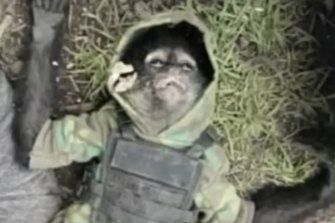Warning: graphic images
Mexico City: Mexican narcos’ fascination with exotic animals was on display this week after a spider monkey dressed up as a drug gang mascot was killed in a shootout, a 200-kilo tiger wandered the streets in the Pacific coast state of Nayarit, and a man died after trying to pet a captive tiger in a cartel-dominated area of western Michoacan state.
Like scenes out of a narco television series, exotic animals have long been part of the Mexican criminal underworld.
The Bengal tiger roamed the streets of Tecuala for some time before quietly accepting a leash.Credit:Twitter/Amazingposts
Photos from the scene of a shootout on Tuesday with police in which 11 drug gang members died, showed a small monkey — dressed in a tiny camouflage jacket and a tiny “bullet-proof” vest — sprawled across the body of a dead gunman who was apparently his owner.
Inexplicably, the well-equipped dead gunman had a plastic bucket on his head.
Authorities in Mexico confirmed the authenticity of the photos, and said it was unclear whether the monkey — which was also wearing a nappy — died in the hail of bullets that killed his owner.
“A primate was killed at the scene, which was presumably owned by a criminal who was also killed at the scene,” state prosecutors said in a statement. “An autopsy will be carried out on the animal by a veterinarian specialised in the species”, he said, and animal-trafficking charges would be considered against the suspects who survived the shootout.
True to form, the monkey quickly got his own “corrida,” the traditional Mexican folk ballad often composed in honour of drug capos.
“Life is very short, it wasn’t the monkey’s turn (to die),” according to the ballad, posted on social media.
The pet monkey, found dead on the scene of the Texcaltitlan shootout, probably belonged to a member of La Familia Michoacana drug cartel. Credit:Youtube/Milenio
Then on Wednesday, the Attorney General for Environmental Protection said it had seized a tiger in Tecuala, in the Pacific coast state of Nayarit, near the border with Sinaloa, which is home to the cartel of the same name.
The office said it acted “after receiving reports about a Bengal tiger that was wandering the streets of Tecuala,” and found that the animal was being illegally kept there.
Those reports were based on a video posted on social media earlier this week, showing a young woman shrieking as she came across the tiger on the street in a residential neighbourhood. “Be quiet, it might come close,” a woman can be heard saying on the video.
Authorities said the tiger’s claws and fangs had been removed and a man can be seen later in the video casually tossing a rope over the tiger’s neck and leading him away.
Perhaps the most tragic story came out of the western state of Michoacan, which has long been dominated by the Carteles Unidos gang and the Jalisco cartel.
On Sunday, authorities confirmed that a man was seriously wounded by a tiger in Periban, Michoacan, a town in the state’s avocado-growing region, where gangs have long extorted protection payments from the lucrative avocado trade.
In a video posted on social media, whose authenticity could not be confirmed, the man is seen calling the tiger to the side of a fenced enclosure. “Come on, come,” the man can be heard entreating.
The man stands outside the enclosure, apparently feeding the tiger with one hand, while he stretches his other arm through the chain-link fence to stroke the animal’s neck.
The man then shrieks in pain after the tiger quickly wheels and bites the extended arm and refuses to let go. Eventually the tiger mauled both the man’s arms.
Michoacan state law enforcement authorities confirmed that the man was taken to a hospital, where he died a few days later from his injuries.
Mexican law allows private citizens to keep exotic animals if they register them under strictly supervised conditions. But Security analyst David Saucedo said criminals sometimes go to the length of getting such permits.
Saucedo said drug traffickers often keep exotic animals as a symbol of status and power, imitating the Colombian drug lords of the 1980s and 90s.
“Mexican drug traffickers copied from the narcos of the Medellin cartel the custom of acquiring exotic animals and setting up private zoos,” said Saucedo. “According to the code of the drug trafficking aristocracy, having a private zoo was a prerequisite for being part of the circle of big-time drug traffickers.”
In some cases, the animals had a more sinister use.
“Some drug cartel capos, like Zetas leader Heriberto Lazcano, acquired exotic animals to torture or disappear their victims,” Saucedo said. “Several of his enemies were devoured by the tigers or the crocodiles that the Zetas kept in their pens or cages.”
Lazcano himself was killed in a shootout with Mexican military personnel in 2012.
AP
Most Viewed in World
From our partners
Source: Read Full Article



